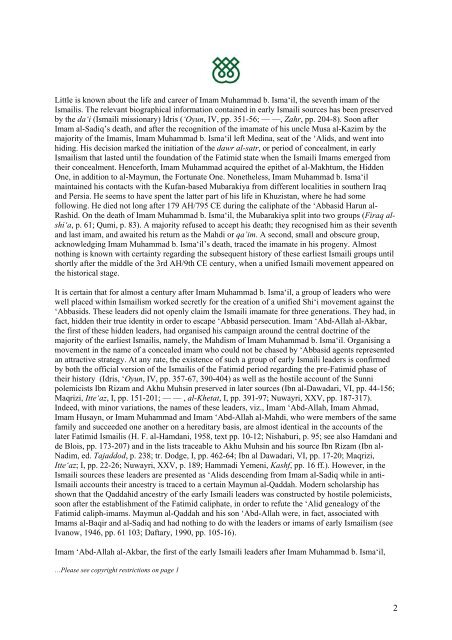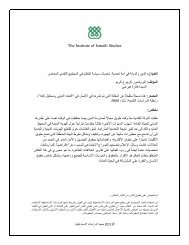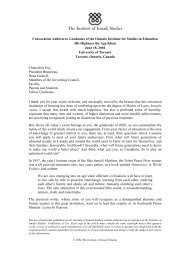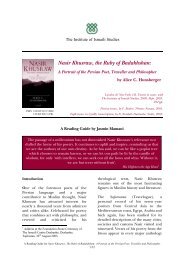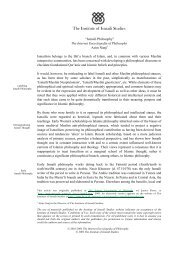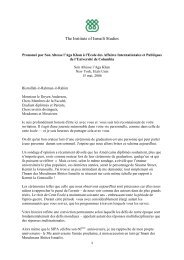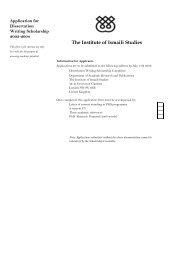The Institute of Ismaili Studies 1
The Institute of Ismaili Studies 1
The Institute of Ismaili Studies 1
Create successful ePaper yourself
Turn your PDF publications into a flip-book with our unique Google optimized e-Paper software.
Little is known about the life and career <strong>of</strong> Imam Muhammad b. Isma‘il, the seventh imam <strong>of</strong> the<br />
<strong>Ismaili</strong>s. <strong>The</strong> relevant biographical information contained in early <strong>Ismaili</strong> sources has been preserved<br />
by the da‘i (<strong>Ismaili</strong> missionary) Idris (‘Oyun, IV, pp. 351-56; — —, Zahr, pp. 204-8). Soon after<br />
Imam al-Sadiq’s death, and after the recognition <strong>of</strong> the imamate <strong>of</strong> his uncle Musa al-Kazim by the<br />
majority <strong>of</strong> the Imamis, Imam Muhammad b. Isma‘il left Medina, seat <strong>of</strong> the ‘Alids, and went into<br />
hiding. His decision marked the initiation <strong>of</strong> the dawr al-satr, or period <strong>of</strong> concealment, in early<br />
<strong>Ismaili</strong>sm that lasted until the foundation <strong>of</strong> the Fatimid state when the <strong>Ismaili</strong> Imams emerged from<br />
their concealment. Henceforth, Imam Muhammad acquired the epithet <strong>of</strong> al-Makhtum, the Hidden<br />
One, in addition to al-Maymun, the Fortunate One. Nonetheless, Imam Muhammad b. Isma‘il<br />
maintained his contacts with the Kufan-based Mubarakiya from different localities in southern Iraq<br />
and Persia. He seems to have spent the latter part <strong>of</strong> his life in Khuzistan, where he had some<br />
following. He died not long after 179 AH/795 CE during the caliphate <strong>of</strong> the ‘Abbasid Harun al-<br />
Rashid. On the death <strong>of</strong> Imam Muhammad b. Isma‘il, the Mubarakiya split into two groups (Firaq alshi‘a,<br />
p. 61; Qumi, p. 83). A majority refused to accept his death; they recognised him as their seventh<br />
and last imam, and awaited his return as the Mahdi or qa’im. A second, small and obscure group,<br />
acknowledging Imam Muhammad b. Isma‘il’s death, traced the imamate in his progeny. Almost<br />
nothing is known with certainty regarding the subsequent history <strong>of</strong> these earliest <strong>Ismaili</strong> groups until<br />
shortly after the middle <strong>of</strong> the 3rd AH/9th CE century, when a unified <strong>Ismaili</strong> movement appeared on<br />
the historical stage.<br />
It is certain that for almost a century after Imam Muhammad b. Isma‘il, a group <strong>of</strong> leaders who were<br />
well placed within <strong>Ismaili</strong>sm worked secretly for the creation <strong>of</strong> a unified Shi‘i movement against the<br />
‘Abbasids. <strong>The</strong>se leaders did not openly claim the <strong>Ismaili</strong> imamate for three generations. <strong>The</strong>y had, in<br />
fact, hidden their true identity in order to escape ‘Abbasid persecution. Imam ‘Abd-Allah al-Akbar,<br />
the first <strong>of</strong> these hidden leaders, had organised his campaign around the central doctrine <strong>of</strong> the<br />
majority <strong>of</strong> the earliest <strong>Ismaili</strong>s, namely, the Mahdism <strong>of</strong> Imam Muhammad b. Isma‘il. Organising a<br />
movement in the name <strong>of</strong> a concealed imam who could not be chased by ‘Abbasid agents represented<br />
an attractive strategy. At any rate, the existence <strong>of</strong> such a group <strong>of</strong> early <strong>Ismaili</strong> leaders is confirmed<br />
by both the <strong>of</strong>ficial version <strong>of</strong> the <strong>Ismaili</strong>s <strong>of</strong> the Fatimid period regarding the pre-Fatimid phase <strong>of</strong><br />
their history (Idris, ‘Oyun, IV, pp. 357-67, 390-404) as well as the hostile account <strong>of</strong> the Sunni<br />
polemicists Ibn Rizam and Akhu Muhsin preserved in later sources (Ibn al-Dawadari, VI, pp. 44-156;<br />
Maqrizi, Itte‘az, I, pp. 151-201; — — , al-Khetat, I, pp. 391-97; Nuwayri, XXV, pp. 187-317).<br />
Indeed, with minor variations, the names <strong>of</strong> these leaders, viz., Imam ‘Abd-Allah, Imam Ahmad,<br />
Imam Husayn, or Imam Muhammad and Imam ‘Abd-Allah al-Mahdi, who were members <strong>of</strong> the same<br />
family and succeeded one another on a hereditary basis, are almost identical in the accounts <strong>of</strong> the<br />
later Fatimid <strong>Ismaili</strong>s (H. F. al-Hamdani, 1958, text pp. 10-12; Nishaburi, p. 95; see also Hamdani and<br />
de Blois, pp. 173-207) and in the lists traceable to Akhu Muhsin and his source Ibn Rizam (Ibn al-<br />
Nadim, ed. Tajaddod, p. 238; tr. Dodge, I, pp. 462-64; Ibn al Dawadari, VI, pp. 17-20; Maqrizi,<br />
Itte‘az; I, pp. 22-26; Nuwayri, XXV, p. 189; Hammadi Yemeni, Kashf, pp. 16 ff.). However, in the<br />
<strong>Ismaili</strong> sources these leaders are presented as ‘Alids descending from Imam al-Sadiq while in anti-<br />
<strong>Ismaili</strong> accounts their ancestry is traced to a certain Maymun al-Qaddah. Modern scholarship has<br />
shown that the Qaddahid ancestry <strong>of</strong> the early <strong>Ismaili</strong> leaders was constructed by hostile polemicists,<br />
soon after the establishment <strong>of</strong> the Fatimid caliphate, in order to refute the ‘Alid genealogy <strong>of</strong> the<br />
Fatimid caliph-imams. Maymun al-Qaddah and his son ‘Abd-Allah were, in fact, associated with<br />
Imams al-Baqir and al-Sadiq and had nothing to do with the leaders or imams <strong>of</strong> early <strong>Ismaili</strong>sm (see<br />
Ivanow, 1946, pp. 61 103; Daftary, 1990, pp. 105-16).<br />
Imam ‘Abd-Allah al-Akbar, the first <strong>of</strong> the early <strong>Ismaili</strong> leaders after Imam Muhammad b. Isma‘il,<br />
…Please see copyright restrictions on page 1<br />
2


